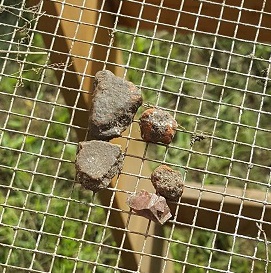by Daniel
Rhodes
Field
Blog October 2 and 4
October
2
In
the past week, we have turned our attention away from the area outside of Fort
Tombecbe would have initially been into an area further east closer to the
property line. This area isn't as easy to access because on one side of the
"path" (I put that in quotes because it isn't a path) are incredibly
thick trees and fine brush, and on the other side is an incredibly sharp barbed
wire fence. The reason we have chosen this area is that it is mentioned quite
frequently in documentation by inhabitants of the fort as areas where a Choctaw
village was located. We started as we always do, doing a surface investigation
with some success finding bits of glass and pottery. We started planting our
flags for our shovel test markers, making them five meters apart instead of the
usual ten, because we had a lot more area to cover than the previous area. It
seemed like every shovel test we found something of note almost instantly,
everything from bits of pottery (pictured below) to a full-sized musket ball,
even a burnt bone chunk (I know chunk is not very scientific). Most of the
pottery sherds were caked with dirt and mud. After cleaning that off, Dr. Dumas
suggested giving it a little lick (I'm not joking about this part.) It helps to
tell the difference between the surface texture of a pottery sherd and an
ordinary rock. I may or may not have called it "Tasting History."
After that, we called it a day. When I got back to my apartment, brushed my teeth several times to make sure I
got the taste of history out of my mouth.

October
4th
Today
started like any other. We did a few more shovel tests and used letters to mark
them on our map this time so as not to mix them up with samples we had taken
from previous shovel test area. All tests will be assigned a Field Specimen
number, or F.S. number to keep them separate from one another. We managed to
get tests I through Q completed, so we got a lot accomplished testing-wise. We
found a few pottery sherds but little else. We will have to wait and see what
results further screening gives us. Connor saw a grub worm in one of his tests
then proceeded to eat it (I didn't see him eat it, but I can't say for sure
that he didn't so…). We packed up and return to the lab and called it a day.
Earlier this week Dr. Dumas loaned me the monograph by James Pate that has all
his research on the Fort's history. It details the French, English, Spanish,
and American occupations. It's so detailed, it has letters and correspondence
between people who occupied the fort and people at outposts elsewhere. The part
I wanted to focus on was the recorded interactions between the fort occupants
and the Native Americans that lived around the fort at the time since so much
of what we have found lately was Native in origin. Since I don't have the
knowledge to say for sure, I could only guess that most of the pottery we've
found was Choctaw and Proto-Choctaw (What the Choctaw were before they were the
Choctaw). We’ve found some shell-tempered pottery, which is pottery made from
shells most likely collected from the Tombigbee River and grog-tempered
pottery, which is pottery made from old or broken pottery. The reason I assume
it is Choctaw is because they are recorded to have numbered in the thousands as
compared to the French occupation of maybe a hundred at the time and how the
French depended on them for survival in the harsh colonial age of Alabama. I
think this is an excellent place to end the week. I've learned a lot and want
to keep reading so I can learn more.